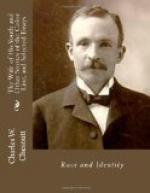It is safe to say that the possession of a million dollars, with the ability to use it to the best advantage, would throw such a golden glow over a dark complexion as to override anything but a very obdurate prejudice. Mr. Spahr, in his well-studied and impartial book on America’s Working People, states as his conclusion, after a careful study of conditions in the South, that the most advanced third of the Negroes of that section has already, in one generation of limited opportunity, passed in the race of life the least advanced third of the whites. To pass the next third will prove a more difficult task, no doubt, but the Negroes will have the impetus of their forward movement to push them ahead.
The outbreaks of race prejudice in recent years are the surest evidence of the Negro’s progress. No effort is required to keep down a race which manifests no desire nor ability to rise; but with each new forward movement of the colored race it is brought into contact with the whites at some fresh point, which evokes a new manifestation of prejudice until custom has adjusted things to the new condition. When all Negroes were poor and ignorant they could be denied their rights with impunity. As they grow in knowledge and in wealth they become more self-assertive, and make it correspondingly troublesome for those who would ignore their claims. It is much easier, by a supreme effort, as recently attempted with temporary success in North Carolina, to knock the race down and rob it of its rights once for all, than to repeat the process from day to day and with each individual; it saves wear and tear on the conscience, and makes it easy to maintain a superiority which it might in the course of a short time require some little effort to keep up.
This very proscription, however, political and civil at the South, social all over the country, varying somewhat in degree, will, unless very soon relaxed, prove a powerful factor in the mixture of the races. If it is only by becoming white that colored people and their children are to enjoy the rights and dignities of citizenship, they will have every incentive to “lighten the breed,” to use a current phrase, that they may claim the white man’s privileges as soon as possible. That this motive is already at work may be seen in the enormous extent to which certain “face bleachers” and “hair straighteners” are advertised in the newspapers printed for circulation among the colored people. The most powerful factor in achieving any result is the wish to bring it about. The only thing that ever succeeded in keeping two races separated when living on the same soil—the only true ground of caste—is religion, and as has been alluded to in the case of the Jews, this is only superficially successful. The colored people are the same as the whites in religion; they have the same standards and mediums of culture, the same ideals, and the presence of the successful white race as a constant incentive to their ambition. The ultimate result is not difficult to foresee. The races will be quite as effectively amalgamated by lightening the Negroes as they would be by darkening the whites. It is only a social fiction, indeed, which makes of a person seven-eighths white a Negro; he is really much more a white man.




